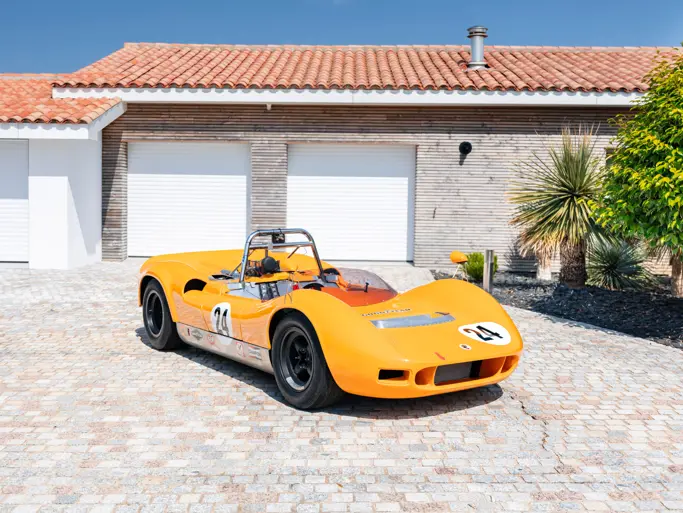1966 Ferrari 330 GT 2+2 by Pininfarina
{{lr.item.text}}
$363,000 USD | Sold
{{bidding.lot.reserveStatusFormatted}}
- Long-term single ownership from 1966 to 2012; showing 79,000 original kilometers
- Largely original interior; cosmetically restored
- Substantial maintenance history, including a recent service
- Documented by marque historian Marcel Massini
- Includes original owner’s manual, tool roll, original spare, wheel chalk, and jack
- Matching-numbers example; Ferrari Classiche certified
Series II. 300 bhp, 3,967 cc SOHC V-12 engine with three Weber 40 DCZ/6 carburetors, five-speed manual gearbox, independent unequal length wishbone front suspension with coil springs, live rear axle with semi-elliptic leaf springs and coil springs over telescopic shock absorbers, and four-wheel dual-circuit Dunlop disc brakes. Wheelbase: 104 in.
By the early 1960s, the intelligent and insightful Enzo Ferrari certainly understood that if he was to continue to have success on a race track with his motorsports team, he needed to provide his well-heeled, discerning customers with a fine touring car that would finance those competitive efforts.
The 330 line, conceived as the successor to the brand’s well-received 250, initially arrived in 1963 with the provisional 330 America. It shared the outgoing 250 GTE’s chassis, but its biggest story was under its long hood, where an evolution of the company’s Colombo Tipo 209 V-12 motor took up residence. Wider bore spacing and a true alternator rather than a dynamo proved to be major advancements. This updated V-12’s slightly longer block and trio of Weber 40 DCZ/6 carburetors gave it 300 horsepower and a 3,967-cubic centimeter displacement, or 330 cubic centimeters per cylinder, which was the figure that gave the car its nomenclature. A four-speed gearbox with overdrive was a natural fit for the cruising-oriented grand touring car.
The 330 America was a placeholder for what was to come, however. The 330 GT 2+2 was a show-stopper when it was unveiled at the 1964 Brussels Motor Show, as it featured unique but controversial quad headlamps. Its distinctive styling was penned by Pininfarina’s noted American designer Tom Tjaarda, who cited an unused Renault headlamp design as his inspiration, and while it once raised eyebrows, it is now notable for its mid-century appeal. However, a year later, when the 330 GT 2+2 Series II arrived, this styling was replaced with a more conventional single headlamp per side arrangement.
The quad headlamps might have garnered a lot of attention in 1964, but it was what was underneath that really defined the 330 GT 2+2. A two-inch-longer wheelbase than the 250 gave the 330 GT 2+2 a more refined, continental driving experience, while high-tech features like Koni adjustable shock absorbers and an all-disc Dunlop dual-circuit braking system enthralled engineers across the globe. The Dunlop-developed braking system gave both the front and rear brakes their own servo assist. In addition, the Series II received a five-speed manual gearbox that replaced the four-speed overdrive unit used previously.
A milestone 1,099 Ferrari 330 GT 2+2s were assembled before the model was discontinued in favor of the more aggressively styled 365 GT of 1967. The 330 GT 2+2 was one of Ferrari’s great early touring cars, and it has proven itself a fine highway companion that is ready for both the wide open autostrada and a winding alpine road. Contemporary media praised the car’s relaxed highway demeanor as well as its remarkable agility.
This later Series II 330 GT was delivered to Ken Regan, an American living in Milan, in June 1966, and it benefitted from the elegant single headlamp arrangement that was introduced a year prior. It was built to European specifications and originally swathed in Argento over Nero Franzi leather. While still in Italy a month later, Regan had the car serviced by the factory at Viale Trento Trieste in Modena, and at that time, the odometer showed 1,069 kilometers.
The car’s American owner later exported it to his home in New York, where he eventually had it painted white and then in the traditional Rosso Corsa. Amazingly, the Ferrari was still under its original owner’s loving care until his passing in 2012. Naturally, that single ownership over the course of many decades means there are no questions or stories about this particular 330 GT 2+2, including no accident history. Service documentation from noted New York City-based Ferrari experts at Donovan Motorcar Services is thoroughly noted by Marcel Massini. Although this 330 GT 2+2 has mostly been stored for the last decade, it was routinely started and serviced and is said to be in excellent running condition today.
Around 80,000 kilometers are showing on the 330 GT 2+2’s odometer, with the vast majority of those being put on during the car’s first two decades. Since the mid-1990s, it has been driven sparingly. The car has recently received a cosmetic restoration, which included finishing the Ferrari in its original Argento color, and it now rides on period-correct wire wheels that are wrapped in Pirelli tires, which were installed by its original owner in the early 1990s. The 330 GT 2+2 has been serviced and detailed under its hood, but it shows no signs of major corrosion or damage. Inside, the original black leather displays a patina that is consistent with its age and single ownership. The original interior combination of Nero Franzi with Rosso carpets has been retained, with new carpets having recently been installed. For further driving enjoyment, a vintage radio and an air-conditioning system have been fitted.
This remarkably straight and largely original 330 GT 2+2 is ready to be immediately enjoyed on the open road, as Enzo himself intended.

 | Phoenix, Arizona
| Phoenix, Arizona


